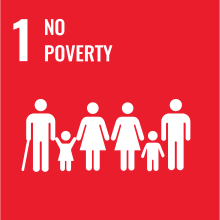Sustainable Development Goals/SDG1
No Poverty - End poverty in all its forms everywhere[2]
- Extreme poverty has been cut by more than half since 1990- however, more than 1 in 5 people live on less than $1.25 a day
- Poverty is more than lack of income or resources- it includes lack of basic services, such as education, hunger, social discrimination and exclusion, and lack of participation in decision making.
- Gender inequality plays a large role in the perpetuation of poverty and its risks; They then face potentially life-threatening risks from early pregnancy, and often lost hopes for an education and a better income.
- Age groups are affected differently when struck with poverty; its most devastating effects are on children, to whom it poses a great threat. It affects their education, health, nutrition, and security. It also negatively affects the emotional and spiritual development of children through the environment it creates.

Learning Task
edit- Explore strategies to reduce or eliminate poverty (e.g. activities performed by Government, Non-Government Organisations (NGOs), individual activities).
- Collect constraints and living conditions that increase poverty? (e.g. war, ...)
- Explain, what can you do to reduce poverty in the world - collect options and access the feasibility!
- Explore the concept of Collaborative Mapping and the impact of Humanitarian Open Streetmap Team HOT on SDG1.
- Explain the link between elimination of poverty and access to sustainable energy!
References
edit- ↑ UN-Guidelines for Use of SDG logo and the 17 SDG icons (2019/05/10) - https://www.un.org/sustainabledevelopment/news/communications-material/
- ↑ "Goal 1: No poverty". UNDP. Retrieved 13 April 2017.
See also
edit- Leave no one behind - United Nations Development Programme
- Eliminating poverty - Learning and Research Project